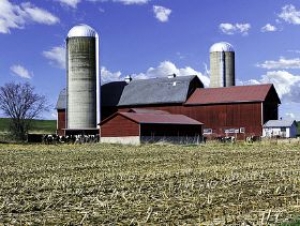Dairy farming

In addition, farmland values across the entire region continued to rise throughout most of the District, according to third quarter survey results from the Federal Reserve Bank of St. Louis.
The Agricultural Finance Survey, conducted from September 15 through September 28, was based on the responses of 75 agricultural banks located within the boundaries of the Eighth Federal Reserve District, which is comprised of all or parts of the following seven Midwest and Mid-South States: Arkansas, Illinois, Indiana, Kentucky, Mississippi, Missouri and Tennessee. The District is broken into four zones: Little Rock, Louisville, Memphis and St. Louis.
For this survey, an agricultural bank is defined as a bank for which at least 15 per cent of its total loans outstanding finances agricultural production or purchases of farmland, farm equipment, or farm structures. Since this is only the second such survey conducted for the Eighth District, historical trends and other factors such as potential seasonal irregularities were not available for evaluation and comparison. Its results should be interpreted carefully and not be used to draw conclusions about longer-term trends.
Farm Income Expectations
Overall, responses from District bankers suggest that farm income and capital spending were significantly lower in the third quarter 2012 compared with third quarter 2011. Based on a diffusion index methodology with a base of 100 (results above 100 indicate proportionately higher lender estimates compared with the same quarter a year earlier; results lower than 100 indicate lower lender estimates), the third quarter index value stood at 80, compared with 140 for the second quarter 2012. Looking forward, lender expectations were lower for the fourth quarter, with an average Eighth District expectations index value of 77.
To be sure, not all of the District's zones saw reduced farm incomes: the Memphis zone reported both higher income and capital spending in the third quarter, compared to this time last year, with its index estimate coming in at 136 for the third quarter. Memphis lenders also indicated they expect that income and spending will remain higher in the fourth quarter as well, as indicated by an index expectations value of 125. In the Memphis zone, which includes northern Mississippi, many crops are irrigated; a factor that has helped offset the impact of the drought.
Farmland Values

Meanwhile, both the value of nonirrigated cropland (or quality farmland) and the value of ranch and pastureland in the Eighth District were expected to continue to rise slightly over the next three months. Cash rents are also expected to rise. Lenders estimated that District quality farmland values averaged $4,886 per acre in the third quarter, with ranch and pastureland averaging $2,345 per acre. Lenders also expect values to continue to rise in the fourth quarter as well, with quality farmland expectations averaging 127 in diffusion index values, and ranch and pastureland values averaging 108.
Compared with the previous quarter's survey, quality farmland values were up 1.6 per cent from a year earlier in the Little Rock zone; down 3.4 per cent in the Louisville zone; up 5.9 per cent in the Memphis zone and up 5.2 per cent from a year earlier in the St. Louis zone. (Note: Since there were a handful of banks who responded to the previous survey but not the current survey, the per centage changes were based on the responses of banks who completed the second- and third-quarter surveys.) Diving deeper into the data, third quarter quality farmland values averaged:
- $2,807 per acre in the Little Rock zone, with a fourth quarter expectations index value of 125
- $4,138 per acre in the Louisville zone, with a fourth quarter expectations index value of 129
- $3,082 in the Memphis zone, with a fourth quarter expectations index value of 136
- $6,003 per acre the St. Louis zone , with a fourth quarter expectations index value of 124
Ranch and pastureland estimates in the third quarter averaged $2,094 per acre in the Little Rock zone with a fourth quarter expectations index value of 111; $2,300 in the Louisville zone with a fourth quarter expectations index value of 133; $1,695 per acre in the Memphis zone with a fourth quarter expectations index value of 82 and $2,621 per acre in the St. Louis zone with a fourth quarter expectations index value of 112.
Ag Loan Demand and Repayments
Across the District, bankers continued to report improvement in the availability of loans. Demand for agricultural loans was expected to increase in the fourth quarter of 2012 relative to year-ago levels, but loan repayment rates were expected to be lower in the St. Louis and Louisville zones. In Memphis, which saw the highest rise in expected farm income levels, bankers indicated they expected loan demand to drop and repayments to rise.
Crop Insurance and the Drought
For this survey, lenders were asked two additional questions to help better gauge the impact of the drought. Lenders were asked how the drought directly impacted farm income in their respective areas and to estimate the share of their agricultural production loans that were covered by crop insurance.
Overall, the banker responses regarding drought impact indicated substantial variability. Close to 100 per cent of respondents in the St. Louis and Louisville zones reported the drought would decrease farm income, while only close to 50 per cent of Little Rock and Memphis lenders reported this would be the case in their areas. Much of this geographical discrepancy is related to the use of irrigation on a larger share of farmland in the Little Rock and Memphis zones.
This survey was developed and conducted with the help of the Kansas City Fed.























